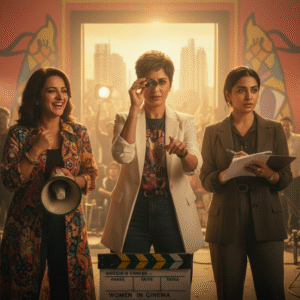Key Metrics (2025):
• Cannes 2025: 4 out of 19 competition films directed by women (Source: Official Cannes Selection 2025)
• Berlinale 2025: 6 of 20 competition entries by women directors, including the Golden Bear winner (Source: Berlinale.de)
• Sundance 2025: Over 50% of selected films across sections helmed by female filmmakers (Source: Sundance Institute)
• Venice 2024 Recap: Only 3 of 23 in competition were women-directed (contextual benchmark)
Global Recognition Still a Climb, But Momentum Builds
In 2025, female directors are continuing to reshape the global cinematic landscape, not just through presence but through consistent excellence across the world’s most respected film festivals. While full parity is still distant, the direction is unmistakably progressive. From Cannes and Sundance to Berlinale and beyond, women-led films are driving critical conversations and winning top honors.
At Cannes 2025, four competition entries were directed by women—a modest figure, yet significant when compared to historical trends. Payal Kapadia, the Indian filmmaker whose previous documentaryA Night of Knowing Nothingwon acclaim, returned this year as a jury member, marking a symbolic shift in representation and influence.
Sundance and Berlinale: Leading the Gender Inclusion Charge
Sundance 2025 stood out once again for its commitment to inclusivity. More than half of the films showcased across its major sections—U.S. Dramatic, World Cinema, Documentary, and NEXT—were helmed by women. According to the Sundance Institute, this was the third consecutive year in which female directors constituted at least 50% of programming, underlining their sustained policy of equity-based curation.
The Berlinale also upheld its progressive reputation. Six of the 20 films in competition were directed by women, including the eventual Golden Bear winner,Little Fires in Oslo, by Norwegian filmmaker Ingvild Sve Flikke. The festival’s official report noted a 22% increase in female submissions compared to the previous year.
New Faces, New Narratives
Beyond the numbers, 2025’s festival circuit is notable for the thematic and stylistic diversity brought by female filmmakers. Stories of climate change, diasporic identity, rural resilience, and reproductive rights found space in prominent slots.
French-Cameroonian director Rosine Mbakam’sThe River Rememberswas lauded at Berlin for its non-linear form and poetic resistance to colonial memory. American director Raven Jackson’sHummingbird Woman, a Sundance standout, explored generational trauma in the Deep South with haunting lyricism.
These films weren’t just included—they were celebrated. Many received standing ovations, distribution deals, and invitations to international forums.
The Persistent Gender Gap in Major Markets
Despite progress, representation remains uneven in mainstream commercial cinema. The Venice Film Festival’s previous edition featured only three women in competition, and large studio-backed festival entries in Toronto and Telluride continue to skew male-dominated.
Industry data also reflects that while festival visibility is increasing, production budgets and marketing resources still disproportionately favor male-directed projects.
Conclusion: Spotlight with Substance
2025 has not delivered full equity, but it has undeniably pushed the global film industry closer to a more balanced and inclusive future. Festivals are becoming increasingly conscious of curating diverse, female-led voices—not just to tick boxes, but because those stories are proving artistically and commercially valuable.
As female filmmakers move from the periphery to the spotlight, the global storytelling ecosystem is being enriched—with new voices, new visions, and new versions of what cinema can be.








